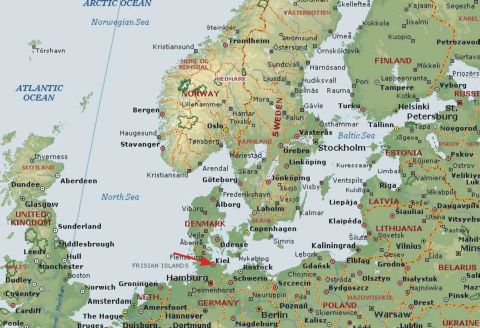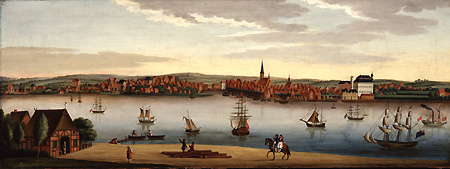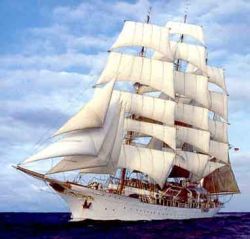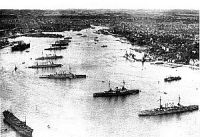Kiel - a Strategic Military Location
The area was
initially settled by Vikings and Normans, but the superb protection offered by the
surrounding waters and the Kieler Ford (Bay, or Kiel Firth), which carves almost 20 km
inland from the Baltic Sea, captured the attention of a future king who would see Kiel’s
location as an ideal area for a garrison. Count Adolf IV of Schauenburg took advantage of
this to build his Holstenstadt tol Kyle there in 1233, declaring the site as a city in
1242. In 1244 a monastery was built, reflecting the area’s rapidly growing population,
and later a wooden fortification was constructed to strengthen the city’s defense. |

|
A castle was also built in the centre of the medieval city, later to be
named the Kieler Schloss (Kiel castle), set on a hill above the firth. The castle later
became the dowager’s residence and secondary residence of the Dukes of Gottorf.
Catherine the Great, Czarina of Russia and also Duchess of Gottorf commissioned extensive
construction and renovation work in 1763, and Russian Tsar Peter III was born in the
castle.
Kiel in the Hands of the Danes
From 1773 to 1864 Kiel was under the King of Denmark, who ruled the state of Holstein
as a fief of the Holy Roman Empire. Various Danish princes would reside in the city’s
castle. But because his control was due only to marital union, the city was not
incorporated into Denmark but remained in German hands. The Roman Empire fell apart in
1806 but the city of Kiel continued to remain under the domain of the king of Denmark, who
served as the Duke of Holstein.

View of Kiel Schloss Castle in 1822
Kiel Becomes a War Port
In 1838 Kiel became the home of HDW Howaldtswerke Deutsche Werft GmbH , a shipyard
famed for its construction of submarines . HDW built the first German submarine
Brandtaucher in 1850, and is today a subsidiary of ThyssenKrupp Marine Systems , the
leading German group of shipyards.
During the Second Schleswig War in 1864, Kiel and the rest of Schleswig and Holstein were
conquered by a German Confederation alliance of the Austrian Empire and the Kingdom of
Prussia . After that Kiel was briefly administered by both the Austrians and the
Prussians, but the Austro-Prussian War in 1866 led to Kiel’s annexation by Prussia in
1867.
In 1865 , King William I moved Prussia's Baltic Sea fleet from Danzig (Gdansk) to Kiel,
whereupon the city exploded in size and importance.
In 1871 Kiel later served as the Imperial War Port. Emperor
Wilhelm II, whose brother Prince Henry of Prussia resided in the city’s castle for 30
years, saw the wisdom of cutting the ford further inland to create the Kiel Canal, carved
across the narrow neck of the Jutland peninsula and which has become the busiest
artificial waterway in the world. The canal was completed in 1895, it has been widened and
deepened over the years, and is almost 100 km long.
Wilhelm also established the Imperial Dockyard there, which increased the city’s
significance and attracted added labour and a further increasing of its population.
Kiel continued to serve as one of the country's main naval bases, increasing dramatically
from a population of less than 20,000 in 1864 to around 200,000 in 1910. However, with
such great aspirations, the historic old town centre and surrounding areas were demolished
to provide room for the growing metropolis. |

|
A Revolution and Hard Times for Kiel
At the end of World War I the German fleet harboured at Kiel was ordered on a last
glorious mission against the British navy. The sailors seeing this as sheer suicide
decided they had nothing to lose by refusing, the government’s lack of response
resulting in the “sailor’s mutiny”, which sparked the German revolution late in
1918. This resulted in the demise of the monarchy and creation of Germany’s first
democracy: the Weimar Republic.

|
After the First World War, the dismantling of the navy had
far reaching consequences, Kiel’s economy completely collapsing. But a later rearmament
under the National Socialists rejuvenated the city’s importance and orientation as a
military production base. Several slave labour camps were set up for the city’s industry
during World War II, but its status as a naval port, submarine production base and
munitions site meant that Kiel became one of the main targets of Allied bombing during the
Second World War. The heavy bombardments reduced most of the remaining old town and almost
all the industrial areas to rubble. |
This destruction was so extensive that in 1944 Kiel was without water
for 3 days, public transport for 8, and no cooking fuel was available for a full three
weeks.
Kiel Becomes a Capital, and a New Era Begins
In 1946 the city, under British occupation, became the seat of government of the new,
autonomous German federal state of Schleswig-Holstein, and became the state’s capital in
1972.
Following the war, Kiel’s population and refugees rebuilt the city from practically
nothing, but with peace and modern standards in mind. By 1953 the city boasted one of
Germany’s first pedestrian zones and became a model of urban planning.
Many festivals became a tradition to draw in tourists, the most famous being the Kiel Week
sailing festival held every year in June.
The city quickly developed into a gateway to the international community for the young
Federal Republic of Germany, practicing “foreign policy at municipal level”, initially
directed at establishing ties with the Scandinavian countries, later with Eastern Europe.
Kiel has become a significant port transporting passengers
and goods to the Baltic states, where the Baltic Sea area is now considered one of the
regions with the greatest development potential of the entire continent.
The harbour, with its large ferries and cruise ships, helps shape Kiel’s maritime image.
Over 1.5 million passengers sail from the modern Norwegenkai, Schwedenkai and Ostseekai
cruise terminals annually. Visitors from Scandinavia, continental Europe and overseas make
a significant contribution to Kiel’s international feel.
Kiel is an incomparable departure harbour for magnificent cruises to the enchanting world
of the Norwegian fjords and major Baltic cities. |

|
Kiel’s proximity near the centre of Europe and its importance as a
shipping junction will certainly play an important role in that development. For that
purpose, the city has been busy establishing firm ties with the Baltic community.
Like this content? Please support it by pressing any or all of these links below:
Copyright © KENAX, by Karel Kosman - All Rights Reserved Worldwide.
Some of the German language combinations we specialise in:
|